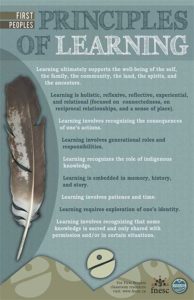- How would you describe the historical and theoretical trends in k-12 open and distributed learning? What did you already know, what do you know now based on the course readings and activities, what do you hope to learn?
What did I know?
In all honesty, open and distributed learning is a topic that I did not know much about before starting #edci339. The only experience I had with online learning environments was my Planning 10 class and a first year class that I took at UVic. Additionally, I had never considered the various theories that can be implemented in open and distributed learning settings.
What did I learn?
I think it is so interesting that online learning environments have been around for decades but up until the COVID-19 outbreak, online classes for primary students seemed almost inconceivable. After reading about the historical trends in K-12 open and distributed learning, I made some connections to my prior knowledge:

Retrieved from: http://www.fnesc.ca/wp/wp-content/uploads/2015/09/PUB-LFP-POSTER-Principles-of-Learning-First-Peoples-poster-11×17.pdf
As we learned last week, online learning is most successful when there is a balance between student-content, student-teacher, and student-student interactions. This weeks readings reinforced this idea as we began to dive into various learning theories. Roberts et al. (2018) reminded us of Dewey and Vygotsky’s theories that focussed strictly on the social aspect of learning. I connected this to the First People’s Principle that states : “Learning is holistic, reflexive, reflective, experiential, and relational…” These ideas have been around since the 1930’s and are still relevant to this day.
One point that resonated with me from this weeks readings was when Bates explained that online learning is “not to replace the teacher, but to use the technology primarily to increase and improve communication between teacher and learners”. I think that so many people are quick to think that online learning lacks the social aspect that schools have to offer and this is absolutely not the case if the teacher creates an environment that encourages online interactions with all of the students.
What am I curious about?
In situations where students have no access to online learning materials, how can we best support them? Are there programs or organizations that work towards providing students in need with the required materials?
Why is online learning not offered to more K-12 students? For example, students with busier schedules, unique learning needs or various other reasons, might actually see higher success rates by joining an online environment. Is there a possibility to create a blended classroom with half the time spent f2f and the other half spent online?
References:
Barbour, M & Labonte, R. (2018) An Overview of eLearning Organizations and Practices in Canada. In R. Ferdig & K. Kennedy (Eds.), Handbook of researchon K-12 online and blended learning (pp. 600-616).Pittsburgh, PA: Carnegie Mellon University ETC Press.
Bates, T.(2014). Learning Theories and Online Learning. [Blog post]. Retrieved from
https://www.tonybates.ca/2014/07/29/learning-theories-and-online-learning/.
Roberts, V. , Blomgren, C. Ishmael, K. & Graham, L. (2018) Open Educational Practices in K-12 Online and Blended Learning Environments. In R. Ferdig & K.Kennedy (Eds.), Handbook of research on K-12 online and blended learning (pp. 527–544). Pittsburgh, PA: Carnegie Mellon University ETC Press.

Leave a Reply
You must be logged in to post a comment.